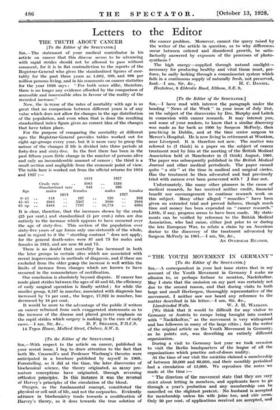Letters to the Editor
THE TRUTH ABOUT CANCER [To the Editor of the SPECTATOR.]
Sin,—The statement of your medical contributor in his article on cancer that this disease seems to be advancing with rapid strides should not be allowed to pass without comment, for it is in flat contradiction to the reports of the Registrar-General who gives the standardized figures of mor- tality for the past three years as 1,002, 999, and 996 per million persons living, and in his comments on cancer statistics for the year 1926 says : " For both sexes alike, therefore, there is no longer any evidence afforded by the comparison of accessible and inaccessible sites in favour of the reality of the recorded increase."
Now, the increase of the rates of mortality with age is so great that no comparison between different years is of any value which does not allow for changes in the age distribution of the population, and even when that is done the resulting standardized index figure gives no correct idea of the changes that have taken place.
For the purpose of comparing the mortality at different ages the Registrar-General provides tables worked out for eight age-groups every year, but it is more easy to grasp the nature of the changes if life is divided into three periods at forty-five and sixty-five. In the first there has been in the past fifteen years little change in the number of persons alive and only an inconsiderable amount of cancer ; the third is a small section and negligible from the economic point of view. The table here is worked out from the official returns for 1913 and 1927
:-
1913 1927
Crude rate .. 1065 .. 1336
Standardized rate 948 996 Age males females males females
1913
1927
0-45 .. 119 .. 197 120
203 45-65 2885 .. 3307 2890
2948 65 up .. 8484 .. 7797 10,778
• • . •
8985
It is clear, therefore, that the increases shown by the crude (25 per cent.) and standardized (5 per cent.) rates are due entirely to the increase which appears to have occurred over the age of sixty-five. This section of the population over sixty-five years of age forms only one-sixteenth of the whole, and in regard to it the " startling contrast " does not apply, for the general death-rates were 87 and 75 for males and females in 1913, and are now 86 and 75.
There, is no doubt that mortality has increased in both the later groups in certain sites which are associated with recent improvements in methods of diagnosis, and if these are excluded from the older group the increase is well within the limits of increase from changes which are known to have occurred in the nomenclature of certification.
One conclusion is absolutely beyond dispute. If cancer has made giant strides between the ages of 45 and 65, the efficiency of early surgical operation is finally settled ; for while the smaller group, 6,167 in number, associated with diagnosis has increased by 74 per cent., the larger, 17,922 in number, has decreased by 16 per cent.
It would be more to the advantage of the public if writers on cancer refrained from such exaggerated statements as to the increase of the disease and placed greater emphasis on the rapid strides which surgery is making in the cure of early








































 Previous page
Previous page